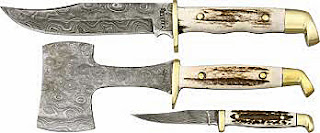A small white cross on the red handle of a
folding knife, such is the trademark that enables one to identify a Swiss Army
Knife at a glance. The incredible story begins with Karl Elsener, who was born
in 1860. Having learned the cutler’s craft in Zug, the town of his forefathers,
he opened his own workshop in 1884 in Ibach and immediately showed his sharpened
sense of marketing, getting himself known through a series of advertisements
published in local papers, and by placing some of his knives in various
clothing accessory shops, including his father’s hat shop. In 1891, he founded
the Swiss Cutlery Guild, whose main objective was to be able, by combined
effort, to do something that no one had yet been able to achieve on his or her
own, that is to manufacture the pocket knife for the army of the Swiss
Confederation. Up until then, the Swiss Military had ordered its knives from
Solingen, the center of German knifemaking.
The first delivery of these new knives was made
in October 1891, consisting of a model called the “Soldier’s Knife,” weighing
144 grams, with wooden plaques for the handle, a single blade, awl, can opener
and screwdriver. But although very robust, it was rather heavy, so an
“officers” model was designed and officially registered on June 12, 1897.
Despite two additional pieces (a second, smaller blade and a corkscrew), this
model was lighter and much more elegant: as for the plaques, they were made
from red fiber. Immediately adopted by the army, great interest was also shown
in these models by a civilian clientele, inside Switzerland at first, and then
far beyond its borders. Over the years these two models have undergone various
evolutions. The “soldier”, for example, was made twenty grams lighter in 1908,
with the wooden sides, whose main defect was that they fissured too quickly,
replaced by others made from fiber. In 1951, using stainless steel again saved
35 grams. In 1961, red alox was used for the sides, and the weight dropped
still further to 72 grams! In 1965, it was trimmed with silver alox, and in
1980 the Swiss escutcheon was placed on it. As for the “officer” model, this
escutcheon was placed on it in 1909, in 1936 the fiber was replaced by
Celluloid, in 1946 the can opener was improved, in 1951 alox was used for the
separators, and in 1968 the initial attachment was replaced by a ring.
The reason why a Swiss blazon was placed on it in
1909 was to designate it clearly as an item of Swiss manufacture and thus
distinguish it from German models, and then from imitations, since it goes
without saying that in any era a good product can only be copied. It was
necessary to identify it better though, and thus protect it, using a commercial
name. In 1909, Karl Elsener’s mother died and he decided to use her first name,
Victoria, for the brand. The firm’s founder worked himself relentlessly,
perhaps even to death, departing this world at the age of fifty-eight; he was
succeeded by his sons, Carl and Alois. In 1921, stainless steel made its
appearance under the name “Inox” and thus was added to the brand, which, when
contracted, became “Victorinox”
But orders, both civil and military, had been so
huge since the establishment of the company that Karl Elsener had never been
able to fully satisfy the demand. That is why another company was created in
Switzerland in 1906, under the name Wenger, which also made Swiss Army Knives
for soldiers, officers and civilians with the same red sides and the same white
cross, but placed at the center of a square with rounded edges. The two
companies have worked together ever since, with each one developing an infinite
range of models so that the tools in these little knives will respond to all
needs.
From the slim four-piece “Soldier’s Knife” to the
imposing twenty-one piece “Toolkit”, who would dare to claim that they couldn’t
find what they were seeking? A special model for hunters with a switchblade
mechanism, another for anglers, yet others for horse riders, golfers, campers,
sailors, skippers, and even a “Special Fireman” model.






